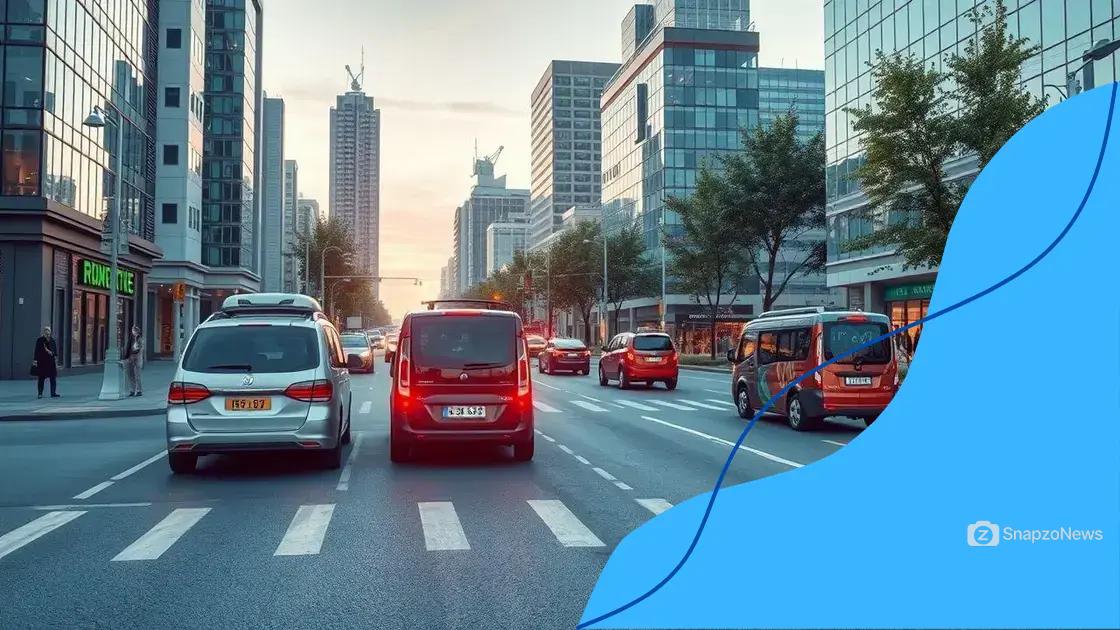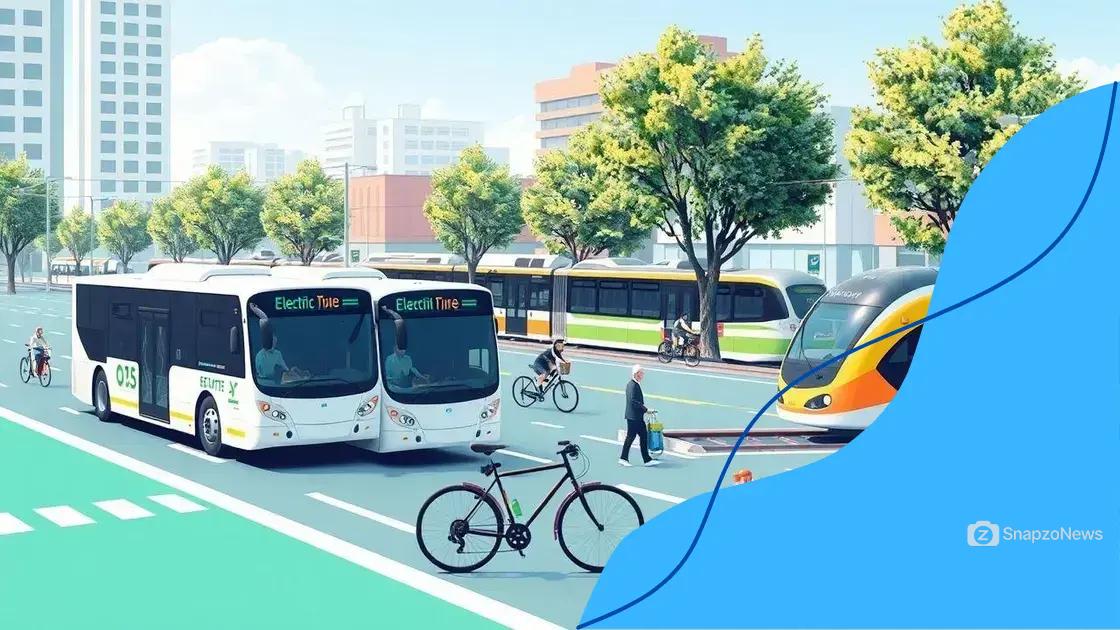Innovations in delivering transportation benefits

Innovations in delivering transportation benefits include electric vehicles, smart infrastructure, and integrated mobility solutions that enhance efficiency, reduce emissions, and improve urban connectivity for a sustainable future.
Innovations in delivering transportation benefits are changing the way we navigate our cities. Imagine smoother commutes and reduced carbon footprints. Curious about how these advancements can make a real difference in your daily life? Let’s dive in!
The role of technology in transportation innovations
Technology is at the heart of recent transportation innovations. As cities grow and populations rise, new solutions emerge to improve our travel experiences. This transformation makes getting around more efficient and eco-friendly.
Smart Transportation Systems
One major advancement is the development of smart transportation systems. These systems utilize real-time data to optimize traffic flow. By using sensors and AI, cities can reduce congestion and lower travel time.
For example, smart traffic lights adjust their timetables based on traffic conditions, which helps to enhance movement in busy areas.
Electric and Autonomous Vehicles
Electric vehicles (EVs) are transforming how we think about personal transportation. With lower emissions, they contribute to a healthier environment. Additionally, many companies are investing in autonomous vehicles. This innovation promises to revolutionize our roads by making travel safer and more accessible.
- EVs reduce greenhouse gas emissions.
- Autonomous vehicles can increase road safety.
- Both technologies lower fuel costs.
As we embrace these technologies, we also see a shift toward public and shared transportation options, making it easier for everyone to access vital services. Advances such as app-based ridesharing have changed how we commute, allowing for more convenient travel solutions.
Additionally, integrating technology with public transport systems can ensure that they run on time and are easy to use. Mobile apps now provide schedules, routes, and live updates, making travel smoother for everyone.
Challenges and Opportunities
While technology brings many benefits, we also face challenges. Infrastructure must adapt to support new innovations. Investments in charging stations for EVs and updates to public transport facilities are essential.
These changes create job opportunities and boost local economies. Embracing transportation innovations not only improves our services but also promoxes sustainability and social growth.
Case studies of successful transportation innovations
Case studies of successful transportation innovations reveal how emerging technologies are making travel easier and more efficient. Examining these real-world applications helps us understand the impact of modern solutions.
Electric Bus Networks
One notable example is the implementation of electric bus networks in various cities. For instance, Los Angeles has integrated electric buses into its public transport system. This move has reduced both emissions and operational costs, illustrating how technology can enhance sustainability.
These networks offer numerous benefits:
- Lower carbon footprints.
- Quieter operation in urban areas.
- Reduced fuel expenses for transit authorities.
As cities expand, the challenge of maintaining clean air becomes critical. Electric buses not only provide a cleaner option but also promote a greener image for urban planners.
Smart Traffic Management
Another successful innovation is smart traffic management systems. Cities like Barcelona have used data analytics to reduce congestion. Using sensors and cameras, these systems monitor traffic patterns in real-time and adjust stoplights accordingly.
This leads to:
- Faster commute times for drivers.
- Lower levels of pollution.
- Enhanced comfort for pedestrians and cyclists.
By prioritizing public safety and efficiency, these systems exemplify the potential of technology in transportation.
Moreover, other cities are following suit by adopting similar technologies. This shift not only improves daily commutes but also inspires more people to use public transport and reduces the overall reliance on private vehicles.
Environmental impact of modern transportation solutions

The environmental impact of modern transportation solutions is a crucial topic as we aim for sustainability. Today, many cities are adopting greener technologies to reduce pollution and enhance air quality.
Reduction of Greenhouse Gas Emissions
One major benefit of these innovations is the significant reduction in greenhouse gas emissions. Vehicles powered by electricity or alternative fuels produce far fewer emissions than traditional gasoline and diesel cars.
This switch leads to:
- Improved air quality in urban areas.
- Healthier living conditions for residents.
- Lower contributions to climate change.
Many cities are also focusing on public transportation as a way to reduce the number of individual cars on the road. Less traffic means less congestion and decreased emissions.
Promotion of Sustainable Practices
Modern transportation solutions promote sustainable practices that encourage people to consider how they travel. For example, bike-sharing programs and electric scooters provide alternatives that reduce the need for cars.
These options often lead to healthier choices, such as biking or walking, which can improve residents’ physical health as well. Additionally, investing in public transit systems allows more people to travel without relying on personal vehicles.
As technological advancements continue, the impact on the environment becomes clearer. Innovations such as electric buses, solar-powered trains, and the development of greener logistics transport contribute further to these efforts. Cities that embrace these developments create a cleaner, greener future.
How transportation innovations benefit urban planning
Transportation innovations greatly benefit urban planning by making cities smarter and more efficient. As cities look to the future, incorporating these advancements allows for better infrastructure and improved quality of life.
Enhanced Connectivity
One of the main benefits is enhanced connectivity. By integrating new technologies, cities can create seamless transit options. This includes linking public transport with bike-sharing systems and ride-hailing services.
A well-connected urban area can:
- Reduce travel times for residents.
- Minimize traffic congestion.
- Encourage people to use public transport rather than cars.
With better connectivity, city planners can design neighborhoods that promote easier access to jobs, education, and services.
Support for Sustainable Development
Transportation innovations also support sustainable urban development. Electric and shared vehicles contribute to lower emissions, which align with environmental goals. When cities implement green transportation, they help fight climate change.
In addition to reducing air pollution, innovations can lead to:
- Better public health outcomes.
- Increased use of green spaces.
- A stronger local economy due to reduced dependency on fossil fuels.
This sustainable approach attracts residents who value eco-friendly solutions and healthy communities.
Over time, as cities adopt these transportation innovations, they create vibrant urban spaces that enhance residents’ lives. By planning for the future with these tools, cities not only improve efficiency but also foster an inclusive atmosphere for all demographics.
Future trends in transportation technology
Future trends in transportation technology promise to reshape how we travel in exciting ways. As technology evolves, these advancements will redefine convenience, safety, and sustainability in urban mobility.
Electric and Autonomous Vehicles
One notable trend is the rise of electric and autonomous vehicles. These cars are not just eco-friendly; they are also designed to enhance safety. For example, autonomous driving systems use sensors and AI to navigate streets while minimizing accidents.
Benefits of these innovations include:
- Reduced emissions from electric vehicles.
- Less traffic congestion due to optimized driving patterns.
- Increased accessibility for individuals who cannot drive.
These vehicles can help create a cleaner and safer road environment for everyone.
Smart Infrastructure
Another critical trend is the development of smart infrastructure. This technology involves the use of sensors and IoT (Internet of Things) devices to gather data on traffic, weather, and road conditions. Cities can use this information to manage traffic more effectively and enhance public transport systems.
Smart infrastructure leads to:
- Real-time traffic updates for commuters.
- Improved public transit experiences.
- Better planning for future roads and transportation needs.
With these tools, cities can adapt to changing transportation demands while promoting efficiency.
Moreover, innovations such as integrated mobility platforms will continue to grow. These platforms allow users to plan and pay for various modes of transport, like buses, trains, and car rentals, all in one app. The result is a more streamlined travel experience that encourages the use of public transport while reducing reliance on personal vehicles.
FAQ – Frequently Asked Questions about Transportation Innovations
What are transportation innovations?
Transportation innovations refer to new technologies and methods that improve the efficiency, safety, and sustainability of travel.
How do electric vehicles impact the environment?
Electric vehicles significantly reduce greenhouse gas emissions, helping to improve air quality and combat climate change.
What is smart infrastructure?
Smart infrastructure includes technology like sensors and IoT devices to monitor and manage traffic, enhancing efficiency and safety in urban areas.
How can transportation innovations benefit urban planning?
They can lead to enhanced connectivity, sustainable development, and improved mobility, creating smarter, cleaner cities for residents.
